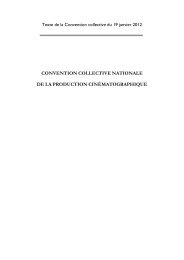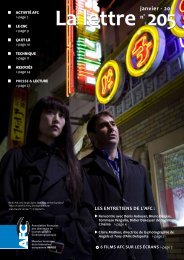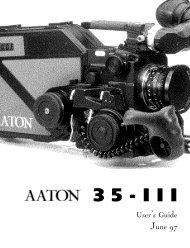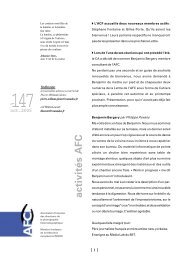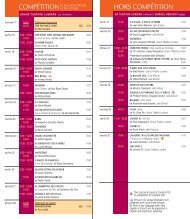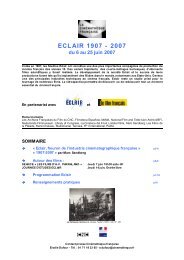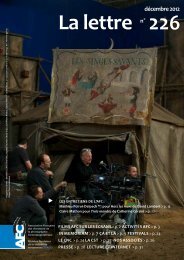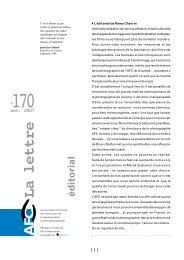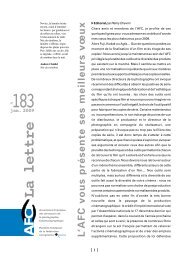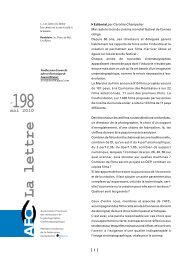Moviecam SL - Used Camera Market for Arri Aaton Zeiss Cooke ...
Moviecam SL - Used Camera Market for Arri Aaton Zeiss Cooke ...
Moviecam SL - Used Camera Market for Arri Aaton Zeiss Cooke ...
You also want an ePaper? Increase the reach of your titles
YUMPU automatically turns print PDFs into web optimized ePapers that Google loves.
FRITZ GABRIEL BAUERPRESENTSTHE USERS GUIDE TO THESUPER - LIGHTWEIGHT MODULARTHE ADVANCED MOS MODULAR 35mmMOTION PICTURE CAMERA FOR MULTIPLEAPPLICATIONS AND INCREASED UTILIZATIONWEB-EDITION 2004Compiled by Frédéric Gérard KaczekIllustrated by Andreas Pauleschitz
TABLE OF CONTENTS1234PREFACE 5MOVIECAM FEEDBACK MAIL 6<strong>SL</strong> CHECKLIST 6CARE AND CLEANING 7BODY OF THE CAMERA SYSTEM<strong>Camera</strong> front 14<strong>Camera</strong> left side 16Control board 17Display 19<strong>Camera</strong> rear 21<strong>Camera</strong> right side 23<strong>Camera</strong> top 24Viewfinder mount plate 25<strong>Camera</strong> base 26OPTICAL VIEWFINDERS AND VIEWFINDERADAPTER PLATE<strong>SL</strong> viewfinder 30Mounting the <strong>SL</strong> viewfinder 32Eyecup 33Eyepiece retaining mount 33Eyepiece heater 34Adjustment of the pivoting eyepiece 35Diopter corrections 36<strong>SL</strong> B&W video camera 37B&W video assist monitor 39<strong>SL</strong> VIDEO VIEWFINDERS, <strong>SL</strong> VIEWFINDERADAPTER PLATE, READOUTS AND MOVIELITESViewfinder adapter plate 42<strong>SL</strong> MAGAZINES<strong>SL</strong> magazines 48Digital footage counter 49<strong>SL</strong> magazine interior 51Roller assembly 52Loading the <strong>SL</strong> magazines 532TABLE OF CONTENTS
5678910<strong>SL</strong> MAGAZINE ADAPTER ANDOTHER MAGAZINES<strong>SL</strong> magazine adapter 60CARRYING HANDLE, LIGHTWEIGHT <strong>SL</strong> BASEAND HANDGRIPS<strong>SL</strong> carrying handle 64Right handgrip 65Left handgrip 66<strong>SL</strong> lightweight base plate 67INTERIOR OF THE <strong>SL</strong>Interior of the camera 70Pitch adjustment control 71Ground glasses 72Changing the ground glasses 73Upper aperture plate/gate 75Lower aperture plate 78Pressure plate 80Mirror shutter 81Setting the shutter angle 82POWER SUPPLIESPower supply unit 86Battery block 88Voltage stabilizer 90THREADING FILM IN THE <strong>SL</strong>Door lock 94Magazine/magazine adapter mounting rail 95Threading film in the <strong>SL</strong> 96Threading film using the <strong>SL</strong> magazine adapter 98Dust check knob 107ACCESSORY BOXES,REMOTE CONTROL AND IRIS CONTROLAccessory connector 110Accessory box interface 111Remote control 1123TABLE OF CONTENTS
1112SUPPORT, FOLLOW FOCUS AND MATTE BOXBase plate 11635/S35 base plate 117Lens support 118Studio follow focus 120Lightweight follow focus 123Matte box 125MISCELLANEOUS AND APPENDIXAssistant work light 130Tools 131Directors finder 132APPENDIXCONNECTORS AND CABLES 1364TABLE OF CONTENTS
PREFACEThe MOVIECAM family has grown - we herewithproudly present our latest ”offspring“, theMOVIECAM <strong>SL</strong>. This very small camera has a weightof 12,55 lbs / 5,7 kg only incl. magazine <strong>for</strong>shoulder operation. Contrary to other ”noisy“ cameras,the <strong>SL</strong> makes, when shooting at 24 or 25 fps, just apleasant, quiet buzzing sound (25 db). Together withthe new body, two new <strong>SL</strong> MAGAZINES, an <strong>SL</strong>OPTICAL VIEWFINDER, an <strong>SL</strong> B&W VIDEO CAMERAand an <strong>SL</strong> CARRYING HANDLE system have beendeveloped so far. In addition, two new <strong>SL</strong>ADAPTERS and an <strong>SL</strong> INTERFACE have beendesigned which allow to use several parts from otherMOVIECAM cameras with the <strong>SL</strong>. For instance,all viewfinder systems of the MOVIECAM COMPACT,incl. several EYEPIECES, READOUTS, VIDEOCAMERAS, VIDEO ASSIST MONITORS andMOVIELITES as well as the MAGAZINES andACCESSORY BOXES can be mounted on the <strong>SL</strong>.Please take the time to read the following pagescarefully. You will see that this new camera offers youa great variety of possibilities and is at the same timeeasy to handle. For descriptions of all compatibleparts of the MOVIECAM family, please consult theupdated edition ‘95 of the COMPACT USERS GUIDE.For further general or technical in<strong>for</strong>mation, please feelfree to contact one of our MOVIECAM rental housesor directly the MOVIECAM Headquarters in Vienna,Austria (<strong>for</strong> addresses and phone numbers, seeappendix). We built this camera <strong>for</strong> you – now youmay enjoy the MOVIECAM <strong>SL</strong>!Gabriel Bauer and Team, Vienna 19955PREFACE
CARE AND CLEANINGLike the other MOVIECAM cameras, theMOVIECAM <strong>SL</strong> is almost maintenance-free. Thereis only one requirement <strong>for</strong> a smooth operation:the camera has to be meticulously clean. There<strong>for</strong>eyou should protect it against any dirt or smudges.Clean the camera exterior with window cleaner(caution - do not moisten connectors!). Cleaning themagazine exterior is identical whether it is ofaluminum or carbon fiber.Only when really necessary, e.g. to remove cameratape gum, should you use alcohol or benzine.Caution: Never use acetone!When applied properly, compressed air is the bestcleaner; a vacuum cleaner or an air syringe will dofine.Cotton tips, orangewood sticks, soft and hardbrushes may be used <strong>for</strong> gentle cleaning.Caution: The camera may be lubricated at aMOVIECAM service center only!7CARE AND CLEANING
[1] [2] [3]RAW STOCKPRESET SETftm[4] [5] [6] [7] [8][10] [11] [12][13][9][18][6][7] [14][15][16] [17]8THE <strong>SL</strong> SYSTEM
Notes:12
The lower connector [1] may be used <strong>for</strong> the remote controlof the on/off button (e.g. RIGHT HANDGRIP button). Thedovetail type accessory bracket [3] is used to hold theCARRYING HANDLE or the LIGHTWEIGHT FOLLOWFOCUS device.15CHAPTER 1THE BODY OF THE <strong>SL</strong> SYSTEM
[4][23][15][10][8][greenLED][24][9][redLED][7]Fig. 3b – CONTROL BOARD[4] - Lens mount lever[7] - On/off button[8] - Connector 24 V / 400 mA[9] - Multi-functional button[10] - Tape measure hook[15] - Cover plate <strong>for</strong> Viewfinder exit[23] - FPS display[24] - FPS input unit[green LED] - <strong>Camera</strong> is running[red LED] - Battery low, out of syncPower (24 V) <strong>for</strong> eyecup heater or ASSISTANT WORKLIGHT is supplied via the connector [8].The tape measure is attached to the hook [10] thatindicates the image plane.The multi-functional button [9] has the following threefunctions:17CHAPTER 1THE BODY OF THE <strong>SL</strong> SYSTEM
CAMERA IS OFF:1.Take-up function:By shortly pressing this button, the film is tightened bythe two magazine winders.2.Dust-check function:By pressing this button approx. 2 seconds, the mirrorshutter is cleared out of the way and thus permits tocheck the film gate without having to open the cameradoor.CAMERA IS ON:3.TV-bar function:By pressing this button during shooting, the imageseparation bar on the TV or computer screen may beshifted toward the bottom of the viewfinder image. Aslong as the bar remains in this position, it is not visibleon film.The camera is switched on by activating either thebutton [7], the RIGHT HANDGRIP button or the buttonon the REMOTE CONTROL.Equally, any of those buttons can be employed toswitch off the camera, and vice versa.18CHAPTER 1THE BODY OF THE <strong>SL</strong> SYSTEM
Fig. 3c – DISPLAYFollowing in<strong>for</strong>mation is provided by the display onthe control board of the MOVIECAM <strong>SL</strong>, on theREADOUT or on the REMOTE CONTROL BOX– MOVIECAM <strong>SL</strong> without ACCESSORY BOX:Flashing when a buckle switch hasbeen interrupted (e.g. badlythreaded film).Stand-by camera.Lighting when camera runs with 12 fps.Flashing when lower speed hasbeen selected.Lighting when camera runs with 24 fps.Lighting when camera runs with 32 fps.Flashing when a higher speed hasbeen selected.Flashing when multi-functional knobis pressed and mirror shutter is inshooting position.Shows malfunction of the drivingsystem (motor, electronics).19CHAPTER 1THE BODY OF THE <strong>SL</strong> SYSTEM
– MOVIECAM <strong>SL</strong> with ACCESSORY BOX:Flashing when speed either too highor low has been selected on SUPERSPEED CONTROL BOX.Lighting when camera runs with 2 fps.Flashing when lower speed has beenselected.Lighting when camera runs with 40 fps.Flashing when higher speed hasbeen selected.Reverse shooting with 12 fps.Flashing when lower reverse speedhas been selected.Reverse shooting with 24 fps.Reverse shooting with 32 fps.Flashing when higher reverse speedhas been selected.Shown when mirror shutter, controlledvia single frame connector, remains inshooting position (approx. 4 seconds).Shown when reverse mode is chosen(SUPER SPEED CONTROL BOX) andan <strong>SL</strong> MAGAZINE is mounted.20CHAPTER 1THE BODY OF THE <strong>SL</strong> SYSTEM
[25a] [20] [25b][14][11][13][16]Fig. 4a – CAMERA REAR[11] - Magazine / Magazine adapter connector[14] - <strong>Camera</strong> opening[16] - Power receptacle[13] - Magazine / Magazine adapter mounting rails[20] - Accessory / STEADICAM attachment[25a] - Magazine / Magazine adapter release button[25b] - Magazine / Magazine adapter lockThe connector [11], mounted mobile to facilitate theplug-in, is used <strong>for</strong> both electronic interface and powersupply <strong>for</strong> the magazine drives.The MAGAZINES (or MAGAZINE ADAPTER) areattached at the camera rear by sliding them onto themounting rail [13].Below the magazine lower mounting rail there is thereceptacle [16] <strong>for</strong> the camera’s 24 V power supply.21CHAPTER 1THE BODY OF THE <strong>SL</strong> SYSTEM
[20] [25a] [25b]Fig. 4b – MAGAZINE/M.ADAPTER LOCKOn top of the camera rear, there is a small unlockingbutton [25a]. When mounting the <strong>SL</strong> MAGAZINE orthe <strong>SL</strong> MAGAZINE ADAPTER to the camera, you willhear a click which indicates that the lock [25b] itselfis engaged in the MAGAZINE/MAGAZINE ADAPTERnotch and the MAGAZINE/MAGAZINE ADAPTER isfirmly mounted. By pressing the small unlocking button[25a], the lock shifts upwards and the MAGAZINE/MAGAZINE ADAPTER can be removed by pulling itgently outward.22CHAPTER 1THE BODY OF THE <strong>SL</strong> SYSTEM
[25a] [21] [20] [10] [15][4][26][16][3][6][2][17][18][1][22]Fig. 5 – CAMERA RIGHT SIDE[1] - On/off button outlet[2] - 24 V outlet[3] - Accessory bracket (Dovetail)[4] - Lens mount lever[6] - Lens mount cap[10] - Tape measure hook[15] - Cover plate <strong>for</strong> VIEWFINDER exit[16] - Power receptacle[17] - Cover plate of the main fuse holder[18] - Accessory bracket[18 ] - Cover plate <strong>for</strong> accessory box interface plug[20] - Accessory/STEADICAM attachment[21] - Threaded socket and gauged boreholes <strong>for</strong>CARRYING HANDLE attachment[22] - Accessory bracket / RIGHT HANDGRIP attachment[25a]- Magazine /Magazine adapter release button[26] - Sync out connectorThe CARRYING HANDLE is attached to the threadedsocket and gauged boreholes [21] on top of thecamera right side; the RIGHT HANDGRIP attachmentplate is slid onto the rail [22]. Below the cover plate[18] there is the interface plug <strong>for</strong> the accessory boxes.The main fuse of the camera (Glass fuse: 6,3 A slow, 5x 20 mm) is located below the cover plate [17].23CHAPTER 1THE BODY OF THE <strong>SL</strong> SYSTEM
[16][25a][30][10][29][20][10][30][27][0][0]Fig. 6a – CAMERA TOP[10] - Tape measure hook[16] - Power receptacle[20] - Accessory / STEADICAM attachment[25a] - Magazine / Magazine adapter release button[27] - Assistant work light bracket[29] - Engraved viewfinder mounting plate[30] - Viewfinder attachment(gauged borehole/threaded sockets)[0] - Retaining screwsThe plate on top of the camera body shows the <strong>for</strong>matthe camera has been adjusted to (either STANDARD 35or SUPER 35 <strong>for</strong>mat).The engraved viewfinder mounting plate [29] is turnedupside down when changing the <strong>for</strong>mat at a rentalhouse.24CHAPTER 1THE BODY OF THE <strong>SL</strong> SYSTEM
Notes:27CHAPTER 1THE BODY OF THE <strong>SL</strong> SYSTEM
CHAPTER 2THE <strong>SL</strong> OPTICAL- AND THE VIDEO VIEWFINDER
CHAPTER 2<strong>SL</strong> OPTICAL- ANDVIDEO VIEWFINDER
Fig. 8 – THE VIEWFINDERSVarious viewfinders may be used with theMOVIECAM <strong>SL</strong> modular system:A) <strong>SL</strong> OPTICAL VIEWFINDERB) <strong>SL</strong> VIDEO VIEWFINDER (B&W VIDEO CAMERA)C) All other OPTICAL and VIDEO VIEWFINDERSof the COMPACT SYSTEMA) The <strong>SL</strong> OPTICAL VIEWFINDER is a lightweightconstruction with integrated beam splitter.The eyepiece is not interchangeable. It can berotated 360° only vertically while maintaining anerect image.B) The <strong>SL</strong> OPTICAL VIEWFINDER permits the use ofthe <strong>SL</strong> VIDEO B&W VIDEO CAMERA (mountedon the top). The light transmission ratio of the builtinbeam splitter is 80% / 20% (80% lighttransmission <strong>for</strong> the eyepiece, 20% <strong>for</strong> the videocamera).30CHAPTER 2THE <strong>SL</strong> OPTICAL- AND THE VIDEO VIEWFINDER
C) By means of the <strong>SL</strong> ADAPTER PLATE all OPTICALand VIDEO VIEWFINDERS of theMOVIECAM COMPTACT system may be used withthe MOVIECAM <strong>SL</strong> including VIDEO CAMERASand VIDEO ASSIST MONITOR, MOVIELITE,REMOTE CONTROL and READOUT systems.31CHAPTER 2THE <strong>SL</strong> OPTICAL- AND THE VIDEO VIEWFINDER
[31][30][32]Fig. 9 – MOUNTING THE <strong>SL</strong> VIEWFINDER[30] - Threaded sockets[31] - Glass surfaces[32] - Gauged boreholeAfter removing both caps, the <strong>SL</strong> OPTICALVIEWFINDER is mounted to the camera body with threeM5 Allen screws.Care should be taken that:1. the VIEWFINDER sits plane on the mount,2. the pin engage easily in the gauged borehole and3. both glass surfaces are absolutely clean.32CHAPTER 2THE <strong>SL</strong> OPTICAL- AND THE VIDEO VIEWFINDER
[A][B]Fig. 10 – EYECUPThe eyepiece has an interchangeable RUBBER EYECUP[A]. To clean the exit pupil [B], remove the EYECUP bysimply pulling it straight out.Eye-friendly covers, such as chamois or cotton cloth,can be easily attached with a rubber band. Anotheruseful cover are the terry cloth ”wrist bands“, wellknownfrom tennis, as they are sweat-absorbing,reusable and easy to attach.Fig. 11 – EYECUP RETAINING MOUNTBelow the RUBBER EYECUP there is a magnetically heldATTACHMENT RING <strong>for</strong> a diopter correction lens orsome special filter.Lens or filter must have a diameter of 31,5 mm.33CHAPTER 2THE <strong>SL</strong> OPTICAL- AND THE VIDEO VIEWFINDER
[8][8]Fig. 12 – EYECUP HEATERA heated eyecup, which eliminates fogging of theexit pupil, is integrated in the eyepiece of theMOVIECAM <strong>SL</strong>.There is no on/off switch <strong>for</strong> the eyecup heater; inorder to activate it, disconnect the camera, plug oneend of the short coiled cable into the eyepiececonnector, the other end into one of the connectors [8].Connectors on camera and eyepiece are identical.34CHAPTER 2THE <strong>SL</strong> OPTICAL- AND THE VIDEO VIEWFINDER
[33][35]Fig. 13 – FRICTION ADJUSTMENT OF THEPIVOTING EYEPIECE/EYEPIECE SHUTTER WHEELThe eyepiece is integrated into the <strong>SL</strong> OPTICALVIEWFINDER and rotatable by 360°. It automaticallygives an upright erect image, regardless of the angleof view.To swing the eyepiece, loosen the tension screw [33]below the eyepiece mount, move the eyepiece andtighten the screw again.To loosen tension brake, turn counter-clockwise.To tighten tension brake, turn clockwise.An integrated eyepiece shutter wheel [35] can be setto two different positions:1) ”OPEN“2) ”CLOSE“35CHAPTER 2THE <strong>SL</strong> OPTICAL- AND THE VIDEO VIEWFINDER
[33][34]Fig. 14 – DIOPTER CORRECTIONThe MOVIECAM <strong>SL</strong> eyepiece may be diopter-adjustedby turning the knurled barrel [34].With the help of a scale, where personal marks maybe added, the assistant can easily adjust the eyepieceto the eyesights of the different people using thecamera. Corrections can be made from -5 to +5diopters.36CHAPTER 2THE <strong>SL</strong> OPTICAL- AND THE VIDEO VIEWFINDER
[15]Fig. 15a +15b – <strong>SL</strong> B&W VIDEO CAMERAAn <strong>SL</strong> B&W VIDEO CAMERA can be attached to the<strong>SL</strong> OPTICAL VIEWFINDER.At the top side of the <strong>SL</strong> OPTICAL VIEWFINDER,below a cover [15], there is the exit pupil <strong>for</strong> the videoimage and a small connector <strong>for</strong> the power supply ofthe VIDEO CAMERA. Always attach the cover to theOPTICAL VIEWFINDER (with two M5 Allen screws)when no VIDEO CAMERA is installed.The VIDEO CAMERA has a similar cover.37CHAPTER 2THE <strong>SL</strong> OPTICAL- AND THE VIDEO VIEWFINDER
[37][43][36][42][44]Fig. 16 – THE <strong>SL</strong> B&W VIDEO CAMERA[42] - On/off switch[43] - rotary (iris) knob[44] - ”Fischer“ connector <strong>for</strong> video assist monitor[36] - BNC video outlet[37] - attachment <strong>for</strong> the video assist monitor.The <strong>SL</strong> B&W VIDEO CAMERA is provided with anattachment and a connector <strong>for</strong> a small on-boardvideo assist MONITOR.At the right side of the B&W VIDEO CAMERA there isa BNC video outlet to connect various devices, e.g.monitors, recorders or transmitters.Caution: When a device is connected, care shouldbe taken that no tension is exerted on the camera -otherwise the connector and thus the video cameraand the MOVIECAM <strong>SL</strong> itself might be damaged!The cables should not restrict the operator’s mobility.38CHAPTER 2THE <strong>SL</strong> OPTICAL- AND THE VIDEO VIEWFINDER
[38][39][40][37][43][44]Fig. 17 – THE B&W VIDEO ASSIST MONITORBy adjusting the mechanical iris of the video cameralens with the rotary knob [43], the video picture isadapted to the brightness of the ground glass image.Mount the small B&W VIDEO ASSIST MONITOR bysliding its rotatable arm onto the accessory brackets[37] on top of the VIDEO CAMERA.Connect it to its ”Fischer“ outlet [44].Caution: Protect the small B&W monitor tube againststrong lights (e.g. strong luminaires in frame) –it might get damaged!Adjust contrast and brightness with the two small knobs[38+39] on the front. Standard defaults should only bechanged if necessary.Caution: Adjust video iris only after lens aperture ofthe MOVIECAM <strong>SL</strong> has been set!In case the monitor is not needed, it can be turned offwith a small switch [40].39CHAPTER 2THE <strong>SL</strong> OPTICAL- AND THE VIDEO VIEWFINDER
CHAPTER 3THE VIEWFINDER ADAPTER PLATEAND THE COMPACT VIEWFINDERS
CHAPTER 3THE VIEWFINDER ADAPTERPLATE AND THE <strong>SL</strong>VIEWFINDERS
[VAP]Fig. 18 – THE VIEWFINDER ADAPTER PLATEAs already mentioned in our Preface, the <strong>SL</strong> CAMERAis compatible with most parts of the COMPACTsystem. Two <strong>SL</strong> ADAPTERS are provided. With the firstone, the COMPACT viewfinder systems can be usedon the <strong>SL</strong>; with the other <strong>SL</strong> ADAPTER, the COMPACTMAGAZINES can be used.The VIEWFINDER ADAPTER PLATE [VAP] is a smallplate with an optical system that is attached to thecamera body like the <strong>SL</strong> OPTICAL VIEWFINDER.On this plate, any COMPACT OPTICAL or VIDEOVIEWFINDER as well as the accessories, such asMOVIELITES, READOUTS and REMOTE CONTROL,may be attached. The VIDEO CAMERAS (B&W orcolor) may also be attached to the COMPACT VIEW-FINDERS. You may fix e.g. the B&W VIDEO CAMERAonto the VIEWFINDER ADAPTER PLATE of theMOVIECAM <strong>SL</strong> <strong>for</strong> remote or STEADICAM operationor the ORIENTABLE VIEWFINDER with LONGEYEPIECE <strong>for</strong> studio operation.42CHAPTER 3THE VIEWFINDER ADAPTER PLATEAND THE COMPACT VIEWFINDERS
For detailed in<strong>for</strong>mation about all these parts, pleaseconsult the COMPACT USERS GUIDE.Caution:Be<strong>for</strong>e mounting the adapter plate, make sure thatall glass surfaces are meticulously clean.Care should be taken that the adapter sits plane onthe camera body.43CHAPTER 3THE VIEWFINDER ADAPTER PLATEAND THE COMPACT VIEWFINDERS
[VAP]44CHAPTER 3THE VIEWFINDER ADAPTER PLATEAND THE COMPACT VIEWFINDERS
[VAP]45CHAPTER 3THE VIEWFINDER ADAPTER PLATEAND THE COMPACT VIEWFINDERS
CHAPTER 4THE <strong>SL</strong> MAGAZINES
CHAPTER 4THE <strong>SL</strong> MAGAZINES
[A][B][C][E][MA][MA]Fig. 19 – THE MAGAZINESMOVIECAM offers two magazines <strong>for</strong> the <strong>SL</strong>:[A] 400 ft / 120 m LIGHTWEIGHT MAGAZINE <strong>for</strong>shoulder operation[B] 400 ft / 120 m LIGHTWEIGHT MAGAZINE <strong>for</strong>STEADICAM operationBoth magazines are extremely light and minimumsized.Caution: There is one important difference to theother magazines of the MOVIECAM family: with the<strong>SL</strong> MAGAZINES, it is not possible to shoot reverse.With a <strong>SL</strong> MAGAZINE ADAPTER [MA], you may usethe following magazines of the COMPACT system onthe MOVIECAM <strong>SL</strong> (<strong>for</strong> shooting in both directions):[C] 1.000 ft / 300 m LIGHTWEIGHT MAGAZINE[D] 1.000 ft / 300 m MAGAZINE[E] 500 ft / 150 m LIGHTWEIGHT MAGAZINE[F] 500 ft / 150 m MAGAZINE[G] 400 ft / 120 m LIGHTWEIGHT MAGAZINE <strong>for</strong>STEADYCAM operation.For more in<strong>for</strong>mation about those magazines, pleaseconsult the COMPACT USERS GUIDE.48CHAPTER 4THE <strong>SL</strong> MAGAZINES
Fig. 20 – THE <strong>SL</strong> MAGAZINESThe digital footage counter displays the remainingfootage; it is powered by its own on-board battery.When a magazine is attached to a powered camera,the magazine battery recharges automatically.In case nothing is displayed (which very rarelyhappens), simply mount the magazine to a poweredcamera in order to load the on-board battery and toreactivate the display. The magazine battery usuallyrecharges automatically during the shooting period.After loading the magazine, use the ”preset buttons“ toinput the length of film loaded.By pressing the ”set button”, the footage counter storesthe input. It counts backward when the camera isrunning.The ”raw stock” display shows the length of remainingunexposed film.49CHAPTER 4THE <strong>SL</strong> MAGAZINES
[A][B]Fig. 21 – THE <strong>SL</strong> MAGAZINESThe small lock lever [A] is, when locked, secured by aspring steel safety tab [B].Open the magazines by pressing the safety tab downand turning the lever counter-clockwise. When closing,the safety tab automatically prevents an unintendedopening.Caution: Do not twist the safety tab!50CHAPTER 4THE <strong>SL</strong> MAGAZINES
[A][A]Fig. 22a – <strong>SL</strong> MAGAZINE INTERIORThe construction of these magazines was based ontwo important aspects: size and weight.Regarding the size, these magazines were built asactive displacement - type magazines. This means thetake-up core continuously shifts from its start positiontowards the feed core, while the feed core itself shiftsbackward.Regarding the weight, these brand-new magazineswere made out of a carbon compound.Compared with aluminium magazines, this means lessweight but still the same stiffness and acousticproperties.Even though the magazines have torque motors,heaters and digital footage counters, they are still verylightweight and thus ideal <strong>for</strong> shoulder or STEADICAMoperation.The core holders are mounted mobile to allow anactive displacement. Be sure that no dust enters thetwo openings [A] at the bottom of the magazine.The core holders are identical with those of the othermagazines described in the MOVIECAM COMPACTor SUPERAMERICA USERS GUIDES.51CHAPTER 4THE <strong>SL</strong> MAGAZINES
[R][B][R]Fig. 22b – <strong>SL</strong> MAGAZINES INTERIORThe difference between these two magazines is thedesign of the light-traps [B] in which the rollerassemblies are mounted. The STEADICAM magazinemount is designed in such a way that, throughoutshooting the 400 ft / 120 m film, the center of gravityis maintained.Important: As soon as film is wound onto the takeupcore, the core will automatically be movedtoward the feed core. For this reason it is essentialthat the small roll [R] is rotating easily.52CHAPTER 4THE <strong>SL</strong> MAGAZINES
[I][H][F][G][J][J][J] Core locks [H] Core holder release knobFig. 23a – LOADING THE LIGHTWEIGHT<strong>SL</strong> MAGAZINES1) Clean darkroom / changing bag.2) Lay the magazine down carefully onto footagecounter side; roller assembly is facing you.3) Lift magazine cover.4) Check and clean magazine.Now put a core [G] on the film plate [F] until youhear a first “click”. Hold the plate and –simultaneously – turn the core gently to the left orright until you hear a second “click”. Only nowthe core is properly seated. In case you do nothear the“clicks”, the core holder [H] pin has 53CHAPTER 4THE <strong>SL</strong> MAGAZINES
[A][B]Fig. 23b – LOADING THE LIGHTWEIGHT<strong>SL</strong> MAGAZINESengaged in the hole of the core already at thebeginning. It is not properly seated – have anothertry. Locked cores are released by pressing therelease knob [H] on core holder. Checking coreholders [I] and core locks [J]: By pressing therelease knob [H] on top of the core holder, the threecore locks move inward.Caution: In case of a malfunction of the coreholder, do not disassemble – magazines shouldbe serviced at a MOVIECAM Rental House.From now on in darkness:5) Put film roll on empty can and place it to themagazine left side.6) Wind off just enough film to insert it in the rollerassembly. Gently push the film into the slot betweenrail [A] and roller [B] until it emerges from the otherside.54CHAPTER 4THE <strong>SL</strong> MAGAZINES
[C][D]Fig. 23c – LOADING THE LIGHTWEIGHT<strong>SL</strong> MAGAZINES7) Pull approx. 50 cm film toward you. Unlock theleft core holder by depressing the release knob [H].Place film roll onto core holder - do not presstoward magazine bottom (caution - film might bescratched!). Because of the displacementmechanism, great care must be taken that the filmrolls on both sides are absolutely flatly wound.8) Insert film from outside into magazine between magazinenose [C] in roller assembly and right roller [D].9) Feed film into core slot so that no acute angle <strong>for</strong>mswhen turning the core clockwise (See page 56 Fig.23d).Wind just enough film around take-up core tomake sure it will not accidentally slide out again.Wound-up film has to be flush with the core and lieflat on the small take-up plate [F]. Make sure thatthe film is not wound up below the recess of thesmall roller [R]. The film windings on the feed sidemust not protrude below plate – film might touch themagazine bottom.55CHAPTER 4THE <strong>SL</strong> MAGAZINES
[R][E][F]WRONG WAYFig. 23d – CORE HOLDER10) Close and latch magazine after checking thatfilm is properly seated.Caution: When closing the magazine, care shouldbe taken that nothing (e.g. changing bag, film bagetc.) is caught between magazine cover and base.When the light is on again:11) Attach a loop protector and12) Feed length of unexposed film into footagecounter.56CHAPTER 4THE <strong>SL</strong> MAGAZINES
Notes:57CHAPTER 4THE <strong>SL</strong> MAGAZINES
CHAPTER 5THE <strong>SL</strong> MAGAZINE ADAPTER
CHAPTER 5THE <strong>SL</strong> MAGAZINE ADAPTER
Fig. 24 – THE <strong>SL</strong> MAGAZINE ADAPTERIn order to mount the magazines from the COMPACTsystem, MOVIECAM offers an <strong>SL</strong> MAGAZINEADAPTER that simulates the COMPACT cameraopening. To mount this ADAPTER to the <strong>SL</strong> body, youhave to slit it onto the rail, like an <strong>SL</strong> MAGAZINE itself.Slide the <strong>SL</strong> MAGAZINE ADAPTER onto the railscarefully until you hear a ”click” and the adapter sitstight.The other side of the ADAPTER is similar to themagazine receptacle of the COMPACT TOP MOUNTADAPTER.The left side of the <strong>SL</strong> MAGAZINE ADAPTER can beopened, which makes threading the film easier.For in<strong>for</strong>mation about the mentioned TOP MOUNTADAPTER and the other compatible MOVIECAMMAGAZINES, please consult the COMPACT USERSGUIDE.60CHAPTER 5THE <strong>SL</strong> MAGAZINE ADAPTER
Notes:61CHAPTER 5THE <strong>SL</strong> MAGAZINE ADAPTER
CHAPTER 6THE <strong>SL</strong> CARRYING HANDLE AND HANDGRIPS
CHAPTER 6THE <strong>SL</strong> CARRYING HANDLEAND HANDGRIPS
[C][A][B][3]Fig. 25 – THE CARRYING HANDLEThe <strong>SL</strong> CARRYING HANDLE is mounted onto theaccessory dovetail bracket [3] and fixed with twoscrews. One screw [A] is tightened with an M5 Allenscrewdriver, the other by turning the knurled knob [B].Make sure to mount the carrying handle firmly andproperly.With the two knurled knobs [C], you may change theposition of the carrying handle.The actual <strong>SL</strong> CARRYING HANDLE is only designed tocarry the camera equipped with the <strong>SL</strong> OPTICALVIEWFINDER. Other CARRYING HANDLES will soonbe designed <strong>for</strong> the <strong>SL</strong> equipped with otherViewfinders.64CHAPTER 6THE <strong>SL</strong> CARRYING HANDLE AND HANDGRIPS
[C][D][A][22] [B] [E]Fig. 26 – THE RIGHT HANDGRIPFor handheld operation, MOVIECAM offers anergonomically designed RIGHT HANDGRIP with built-inon/off button [A]. This button works like an ”alternatingswitch“: you can switch on the camera with thehandgrip button and switch it off with the other one [7]on the camera left side and vice versa. The RIGHTHANDGRIP is fixed to the MOVIECAM <strong>SL</strong> by means ofa small MOUNTING RAIL [B]. The mounting rail is slidonto the handgrip attachment [22] of the camera andhas a rosette with screw whose mobile latch permitseasier handling. Due to the rosette joint [C], the RIGHTHANDGRIP may be attached firmly at any verticalangle.A further accessory is the RIGHT HANDGRIPEXTENSION [D] that permits to adjust the handgripposition ergonomically. This extension facilitates thesimultaneous use of the RIGHT HANDGRIP andSTUDIO FOLLOW FOCUS.Do not <strong>for</strong>get to tighten the screws [E] and to connectthe handgrip plug to the on/off button outlet( Fig.2) [1].65CHAPTER 6THE <strong>SL</strong> CARRYING HANDLE AND HANDGRIPS
[A][B][A][C]Fig. 27 – THE LEFT HANDGRIPMOVIECAM provides an additional handgrip <strong>for</strong> thecamera left side that can be turned in any direction.Slide the handgrip onto the support rods and tighten atboth sides. To change the handgrip position, lift bothlatches [A] and loosen the screws [B].In the desired position, tighten the screws in bothrosette joints [C] and put the latches down again.Caution: The LEFT HANDGRIP is only an additionalsupport - do n o t use as carrying handle (one-sidedstrain!).66CHAPTER 6THE <strong>SL</strong> CARRYING HANDLE AND HANDGRIPS
Fig. 28 – THE <strong>SL</strong> LIGHTWEIGHT BASE PLATEAn extremely lightweight <strong>SL</strong> BASE PLATE has beendesigned <strong>for</strong> hand held operation with theMOVIECAM <strong>SL</strong>.This base plate consists of two parts:One part is attached to the camera, the other to thecamera head. To attach the camera to the camerahead, simply slide the plate rods into theircounterparts.Caution: This base plate is available only <strong>for</strong> theStandard 35 configuration.67CHAPTER 6THE <strong>SL</strong> CARRYING HANDLE AND HANDGRIPS
CHAPTER 7THE INTERIOR OF THE <strong>SL</strong>
CHAPTER 7THE INTERIOR OF THE <strong>SL</strong>
[E][F][D1][G][H][D2][K][X][Y][C][B][O][N1][M1][L1][I][J][A][L2][M2][N2]Fig. 29 – THE <strong>SL</strong> INTERIOR[A] Movement block[B] Lock lever <strong>for</strong> lower aperture plate[C] Lower aperture plate[D1] Upper aperture plate[D2] Gate[E] Handle of upper aperture plate[F] Lock lever <strong>for</strong> upper aperture plate[G] Front film guide[H] Pressure plate[I] Pressure block[J] Lever of movement block[K] Inching knob[L1] Upper rear film guide[L2] Lower rear film guide[M1] Upper sprocket[M2] Lower sprocket[N1] Release knob <strong>for</strong> upper rear film guide[N2] Release knob <strong>for</strong> lower rear film guide[O] Buckle switch[X] Mounting rail <strong>for</strong> aperture plates (hided)[Y] Pitch adjustment screw70CHAPTER 7THE INTERIOR OF THE <strong>SL</strong>
In order to adjust the movement to the properties anddimensions of the film material in use and at the sametime achieve an even more quiet and gentle filmtransport, a pitch adjustment control has been built intothe movement block of the <strong>SL</strong>.The pitch adjustment screw [Y] has no marks and nobuffer stop; the adjusting range is a whole turn of thescrew.While the camera runs with normal frame speed (24 -25 fps) and the material to be used, with an M5 Allenscrewdriver, by slowly turning clockwise or counterclockwise,the position is looked <strong>for</strong> in which thecamera runs most smoothly and quiet. This position isjust a small segment of a screw turn.Remark:The interior of the <strong>SL</strong> looks similar to that of the otherMOVIECAM cameras, but the rear film guides and therear buckle switches are mounted differently. Both rearfilm guides can be opened by pressing the releaseknobs [N1, N2] or closed by pushing the guidestowards the sprocket wheels. Notice that the upperwheel has, contrary to the one of the MOVIECAMCOMPACT, two rows of sprockets.The movement block and other parts, like the LOWERAPERTURE PLATE, the GROUND GLASSES, the mirrorshutter etc. are identical with those of the MOVIECAMCOMPACT.The description of those parts can be found in theCOMPACT USERS GUIDE.The UPPER APERTURE PLATE (gate) as well as thePRESSURE PLATE of the <strong>SL</strong> have newly designed grips– they are not compatible with other MOVIECAMcameras.71CHAPTER 7THE INTERIOR OF THE <strong>SL</strong>
Fig. 30 – GROUND GLASSESThe <strong>SL</strong> is equipped with the same GROUNDGLASSES as the other MOVIECAM cameras.GROUND GLASSES with the following markings areavailable:STANDARD 35 <strong>for</strong>mats:1 : 1.375 (Academy)1 : 1.375 + TV1 : 1.375 (camera + projector)1 : 1.375 + 1 : 1.661 : 1.375 + 1 : 1.751 : 1.375 + 1 : 1.851 : 1.661 : 1.66 (camera + projector)1 : 1.66 + TV1 : 1.66 + 1 : 1.851 : 1.78 (HDTV)1 : 1.851 : 1.85 (camera + projector)1 : 1.85 + TV1 : 2.35 (scope)SUPER 35 <strong>for</strong>mats:Superscope 35Superscope 35 (camera + projector)Superscope 35 + TVSuper 1 : 1.85Super 1 : 1.85 + TV72CHAPTER 7THE INTERIOR OF THE <strong>SL</strong>
Fig. 31a – CHANGING THEGROUND GLASSESThe ground glass of the MOVIECAM <strong>SL</strong> lies flat ontop of the mirror shutter and has a metal holder witha thread in the right front corner. Use theMOVIECAM COMBITOOL [T4] to exchange theground glass as follows:1. Disconnect the camera2. Remove lens or cavity cap.3. Open the camera door. Turn the inching button[K] to clear the mirror shutter out of the way.4. Screw the MOVIECAM COMBITOOL into theGROUND GLASS metal holder. 73CHAPTER 7THE INTERIOR OF THE <strong>SL</strong>
Fig. 31b – CHANGING THEGROUND GLASSESWhen the COMBITOOL sits tight, pull out the groundglass gently.5. Clean the GROUND GLASS gently with a verysoft brush or a vacuum cleaner.Caution: Do not touch with fingers or a solidobject! Do not moisten or wipe!6. When screwing the COMBITOOL in or out,hold the ground glass holder only.7. Push the GROUND GLASS gently all the way inuntil it rests against the stop and unscrew theCOMBITOOL.Caution: Never place the ground glass on itsedges. Do not <strong>for</strong>ce!74CHAPTER 7THE INTERIOR OF THE <strong>SL</strong>
[d][b][c][a][e]Fig. 32 – UPPER APERTURE PLATEFilm Gate with Gate Matte is integrated in the UPPERAPERTURE PLATE.Four UPPER APERTURE PLATES are available:1 : 1.33 Full aperture1 : 1.375 Academy1 : 1.661 : 1.85These aperture plates are made of extremely hardmaterial; the film touches the plate only in theper<strong>for</strong>ation area. To avoid deposits, e.g. hair or filmdust, the fine Gate Matte [a] in the aperture plate isslightly recessed. The openings [b] <strong>for</strong> the registrationpins are located left and right of the gate. A guiderail [c] is attached to the aperture plate right side.Clean the aperture plate carefully and regularly - bestwith a vacuum cleaner. Only when it is badlysmudged – which will rarely be the case whenhandled properly and carefully – should you clean itwith a small brush or an orangewood stick.Caution:Never ever lubricate the aperture plate!75CHAPTER 1THE BODY OF THE <strong>SL</strong> SYSTEM
[E][F][J]Fig. 33a – MOUNTING OF THE UPPERAPERTURE PLATEThe image plane is located between the UPPERAPERTURE PLATE and the PRESSURE PLATE. Bothaperture plates (upper and lower) are attached tonotched brackets. For mounting, the UPPERAPERTURE PLATE has V-shaped notches at its top [d]and bottom [e] edges. These notches must beabsolutely clean to make sure the aperture plate canbe seated properly. The V-shaped bottom edge ofthe UPPER APERTURE PLATE, seated on the rail [X], isheld by a spring loaded lever. When removing theUPPER APERTURE PLATE,1. push back the movement by turninglever [J] clockwise,2. lift the small lever [F] and pull out UPPERAPERTURE PLATE by its handle [E].Caution: Be careful not to damage aperture plateor gate - this might have serious consequences!76CHAPTER 1THE BODY OF THE <strong>SL</strong> SYSTEM
[F][E][X]Fig. 33b – MOUNTING OF THE UPPERAPERTURE PLATEInsert the UPPER APERTURE PLATE on the rail [X] andpress <strong>for</strong>ward gently while lifting the small lever [F]and bringing it back to its resting position (= lock)again. You can insert the aperture plate only parallelto the rail [X]!Caution: In case the aperture plate is slanting,start inserting again.77CHAPTER 7THE INTERIOR OF THE <strong>SL</strong>
[X][C][J][B]Fig. 34 – LOWER APERTURE PLATELike the upper plate, the lower one also hasV-shaped notches at its top and bottom edges.The LOWER APERTURE PLATE has two slots <strong>for</strong> thepulldown claws.Notches, slots and surface of the aperture plate mustalways be clean – check regularly. Like the UPPERAPERTURE PLATE, the lower plate is attached tonotched brackets.When removing the LOWER APERTURE PLATE,1. slide back the movement block byturning lever [J];2. press the small lever [B] down;3. hold the released aperture plate [C] atits base and remove it.78CHAPTER 7THE INTERIOR OF THE <strong>SL</strong>
To insert the LOWER APERTURE PLATE, follow thesteps described below:1. Insert the LOWER APERTURE PLATE inthe camera below the movement block;2. pull LOWER APERTURE PLATE up and swingslightly toward camera front until ittouches the rail [X].3. Simultaneously, pull down the smalllever [B] and press the lower part ofthe aperture plate in.4. Lock the LOWER APERTURE PLATE in thecamera by releasing the spring loadedlever [B].79CHAPTER 7THE INTERIOR OF THE <strong>SL</strong>
[G][B][H][I][a]Fig. 35 – PRESSURE PLATEIn the front center of the front film guide [G], there is anopening <strong>for</strong> the PRESSURE PLATE [H]. This plate has tworaised surfaces [a] that hold the film in the gate planewith a spring loaded pin. Smudged surfaces inevitablycause film scratches! To clean the pressure plate,remove it as described below:1. Swing the pressure block [I] backward.2. Lift and remove the pressure plate.3. Check PRESSURE PLATE and both surfacesthoroughly and - if necessary - clean them with lintfreecloth or orangewood sticks. Clean also thecavity at the rear of the pressure plate.The spring is pressed into this cavity. The spring loadedsteel pin [B] in the pressure block presses the plate ontothe film with a certain <strong>for</strong>ce. When tapped lightly, thepin should move easily and spring back to its <strong>for</strong>merposition.80CHAPTER 7THE INTERIOR OF THE <strong>SL</strong>
Fig. 36a – MIRROR SHUTTERThe opening angle of the mirror shutter ranges from22,5° to 180°. To check or adjust the mirror shutterangle, proceed as follows:1. Important: disconnect the camera.2. Remove lens or cavity cap and open the cameradoor.81CHAPTER 7THE INTERIOR OF THE <strong>SL</strong>
[b][a][T4]Fig. 36b – MIRROR SHUTTER3. Advance mirror shutter [a] with inchingknob [K] until shutter angle mark [b] isvisible in the lens mount.4. Insert the MOVIECAM COMBITOOL [T4]in the small opening below this mark andturn it until you get the desired mirrorshutter angle marked on the scale [b].The mirror shutter has six positive stops <strong>for</strong> thefollowing shutter angles:22,5°, 45°, 90°, 120°, 144°, 172.8°, 180°.82CHAPTER 7THE INTERIOR OF THE <strong>SL</strong>
Notes:83CHAPTER 7THE INTERIOR OF THE <strong>SL</strong>
CHAPTER 8THE POWER SUPPLIES
CHAPTER 8THE POWER SUPPLIES
[a] [b] [c] [d][g][h][f][e]Fig. 37 – THE POWER SUPPLY[a] - Main switch[b] - <strong>Camera</strong> supply 24V / 8A stabilized[c] - Charge start button[d] - Charger control green LED[e] - Plug socket 110V or 220V[f] - Battery charger 24V / 1,3 A[g] - Connector 110V / 220V, 50/60 Hz[h] - Fuserear side 1 x 2 A glass fusefront side 8 A automatic fuse2 A automatic fuse2 A automatic fuse2 A automatic fuseThe camera is powered either by the MOVIECAMPOWER UNIT or a MOVIECAM BATTERY BLOCK.The MOVIECAM <strong>SL</strong> is operated with a constantvoltage of 24 V. Under normal working conditions(approx. 25° C / color film in <strong>SL</strong> 400 ft - 120mMAGAZINE / 24 fps), the camera consumes 2,5A.The camera red diode lights up in case the voltagedrops below 20,5 V.86CHAPTER 8THE POWER SUPPLIES
The integrated, thermostatically controlled heatingelements need approx. 15 W, even when the camerais not running.A stabilized 24 V (direct current) outlet, a 110 V /220 V (alternating current) outlet and a lead batterycharger are integrated in the POWER UNIT body.Caution:Prior to connecting the power unit with the mains,check the given voltage and, if necessary, adjust theselector at the power unit rear accordingly!When the camera is connected, you cansimultaneously charge a BATTERY BLOCK. You have toswitch on the main button [a] of the POWER UNIT notonly to operate the camera (switch lights red), but alsowhen the power unit serves as battery charger.Charging needs approx. 4-6 hours and is indicated bya green diode [d] lighting up. It fades out when thebattery is fully charged. Start charging by pressing thesmall button ”charge“ [c].Use the plug socket [e], secured by a 2 A automaticfuse, to charge a second battery block via its in-builtcharger or to supply e.g. an ”Obie light“ (max. 300 W/ 220 V) or a video recorder.At the power supply unit rear, there are the voltageselector and the glass fuse 2 A slow (5 x 20 mm).87CHAPTER 8THE POWER SUPPLIES
[a] [b] [c]Fig. 38 – THE MOVIECAM BATTERY BLOCKThe 7Ah 24V MOVIECAM BATTERY BLOCK is anassembly of lead cells.To charge, either connect the BATTERY BLOCK to thePOWER SUPPLY UNIT charger or use the built-incharger.The built-in charger [c] operates with 220 V.Caution: Prior to operating the built-in charger witha different voltage, contact the rental house!The green LED [b] lights up during charging period.After the BATTERY BLOCK has been fully charged, inapproximately 6 hours, the on-board charger switchesoff and the LED extinguishes.To operate the MOVIECAM <strong>SL</strong>, plug the red CAMERACABLE into the 24 V outlet [a].88CHAPTER 8THE POWER SUPPLIES
[16] [17][16] - Power receptacle[17] - Cover of the Main Fuse mountFig. 39 – CAMERA POWER SUPPLYMOVIECAM provides two special coiled cables.The blue cable connects the mains with the POWERSUPPLY unit. The red cable connects the POWERSUPPLY unit or a BATTERY BLOCK with the <strong>SL</strong>.Both coiled cables may be stretched up to approx.2,5 m. Do not overstretch!As the voltage may drop up to 1 V per cable length(depending on the power consumption of the camera),do not use a longer cable.The camera cable can be easily plugged into thesloped connector [16].The leverage caused by connector length and cableweight resp. strain might damage the socketattachment. There<strong>for</strong>e it is recommended to protect itagainst tension, e.g. by attaching the cable at the fluidor geared head.If the camera is properly connected to a power supply(loaded battery or main adapter), the display will lightup and the camera is ready to run. In case it does notlight up, you have to check with a meter if 24 V aresupplied. If this is the case, remove the small cover[17] and exchange the glass fuse 5 x 20 mm (6,3 A/ slow). If the display does not light up or the cameradoes not run after the exchange, the camera has to bechecked at the rental house.89CHAPTER 8THE POWER SUPPLIES
to camera[a][b]from batteryFig. 40 – ADJUSTABLE VOLTAGE STABILIZERThe MOVIECAM DC-DC converter stabilizes thebattery voltage to the maximum per<strong>for</strong>mance <strong>for</strong> the <strong>SL</strong>.The input range is 18 – 36 V dcThe output range is 24 – 28 V dcThe max. output power is 150 W.Operation:1. plug the battery cable to the power receptacle atthe base of the unit,2. adjust the desired voltage, e.g. 24 V, by means ofa 2mm screw driver introduced in the little hole onthe top of the unit [a],3. connect the Adjustable Voltage Stabilizer to thecamera,4. A strap [b] should help you securing the Stabilizerin order to prevent any restriction of the camera’sand operator’s movement.90CHAPTER 8THE POWER SUPPLIES
Notes:91CHAPTER 8THE POWER SUPPLIES
CHAPTER 9THREADING THE <strong>SL</strong>
CHAPTER 9THREADING THE <strong>SL</strong>
[25a][25b][13][Q][P][13]Fig. 41 – CAMERA DOOR LOCK[13] - Mounting rail[25a] - Magazine / Magazine adapter release button[25b] - Magazine / Magazine adapter lock[P] - Door lock conterpart[Q] - Rear buckle switchThe door lock is designed in a way that, when turningthis lock, the door is pressed onto the body whichprotects it against light leakage.In case the door does not close properly, checkwhether the movement block is in its front position andthe film guides are closed.Only then the door can be locked properly.94CHAPTER 9THREADING THE <strong>SL</strong>
[13][25a][Q]Fig. 42 – THE MAGAZINE/ADAPTERMOUNTING RAILContrary to the magazine receptacle of theSUPERAMERICA and the COMPACT, where themagazines are suspended on a rail and swingtowards the camera body, the magazine receptacle ofthe <strong>SL</strong> is designed with an upper and a lower rail [13]where the <strong>SL</strong> magazines are slid on.On top of the mounting rail is a lock to secure themagazine or the adapter. By pressing the small knob[25a], this lock [25b] (Fig. 42) is released and themagazine or magazine adapter can be removed.The rear buckle switch [Q] is located on a plate in themiddle of the magazine receptacle.This plate serves at the same time as counterpart of thedoor lock.95CHAPTER 9THREADING THE <strong>SL</strong>
[N1][L1][J][L2][N2]Fig. 43 – THREADING FILM IN THE <strong>SL</strong>1. Open camera door.2. Bring the movement to its rear position by turningthe lever [J] clockwise.3. Swing away the rear film guides [L1+ L2] bypressing the release knobs [N1+ N2]4. Pull film loop (approx.10 cm) out of magazine.96CHAPTER 9THREADING THE <strong>SL</strong>
[13][13]Fig. 44 – THREADING FILM IN THE <strong>SL</strong>5a. Threading the film in the <strong>SL</strong> using the<strong>SL</strong> MAGAZINESSlide the magazine onto the body until you hear a”click”.Take care not to put the magazine on its edges,do not <strong>for</strong>ce!97CHAPTER 9THREADING THE <strong>SL</strong>
[MA]Fig. 45a – THREADING FILM IN THE <strong>SL</strong>5b. Threading the film in the <strong>SL</strong> using the <strong>SL</strong>MAGAZINE ADPTER [MA] and COMPACTMAGAZINESInstall the <strong>SL</strong> MAGAZINE ADAPTER like an <strong>SL</strong>MAGAZINE by sliding it onto the rail until you heara ”click”.98CHAPTER 9THREADING THE <strong>SL</strong>
[MA][D]Fig. 45b – THREADING FILM IN THE <strong>SL</strong>Attach magazine mounting claw to the adaptermounting rail. Insert film loop through the adapterin the camera.For easier threading, the adapter door [D] can beopened.Grab the film loop and swing magazine <strong>for</strong>wardtoward the adapter until it engages in the latch.99CHAPTER 9THREADING THE <strong>SL</strong>
[D]Fig. 46 – THREADING FILM IN THE <strong>SL</strong>Caution: The latch of the adapter must be open!Do not crimp or fold the film!Do not <strong>for</strong>get: Lock the magazine on the adapter bypulling the adapter locking lever <strong>for</strong>ward. 100CHAPTER 9THREADING THE <strong>SL</strong>
[M1][M2][L2]Fig. 47a – THREADING FILM IN THE <strong>SL</strong>From now on same handling with <strong>SL</strong> or COMPACTMAGAZINES.6. Pull film loop toward film gate and insert betweenfilm guides [L1 + L2] and sprocket-wheels [M1 +M2].101CHAPTER 9THREADING THE <strong>SL</strong>
[L1][M1][A][M2][L2]Fig. 47b - THREADING FILM IN THE <strong>SL</strong>Then thread film between film gate and movementblock [A] in a not too narrow loop.Caution: As soon as you connect the camera, thefilm winders are shortly activated to tighten the film.Turning the inching button also activates thesewinders. To avoid this when loading film, justdisconnect the camera from power.102CHAPTER 9THREADING THE <strong>SL</strong>
[M1][L1][M2][L2]Fig. 48 – THREADING FILM IN THE <strong>SL</strong>7. Swing guide rails toward the sprocket-wheels[M1 + M2] by moving the latches [L1 + L2]. 103CHAPTER 9THREADING THE <strong>SL</strong>
[J][K1][A]Fig. 49 – THREADING FILM IN THE <strong>SL</strong>8. Turn the lever [J] with one hand gently counterclockwiseto move the movement block [A] into itsfront position. Simultaneously, turn inching knob[K] with the other hand to the left and right withinthe range of the ”TWIST“ mark to engage thepulldown claws gently and properly in the filmper<strong>for</strong>ations. Only then lock the movement blockby further turning the lever [J] counter-clockwiseuntil it engages in its front position.Caution:Sprocket must engage properly in per<strong>for</strong>ation!104CHAPTER 9THREADING THE <strong>SL</strong>
[M1][K]Fig. 50 – THREADING FILM IN THE <strong>SL</strong>9. To adjust loop length, turn inching knob [K] to theposition (dot) marked ”LOOP”.10. Form upper film loop to the ”LOOP” markengraved on the rear side of the camera interiorby depressing and turning the sprocket button [M1].105CHAPTER 9THREADING THE <strong>SL</strong>
[M2]Fig. 51 – THREADING FILM IN THE <strong>SL</strong>11. Repeat this procedure with the lower film loop.12. Film should always be tightened now by thewinders. If not, check that the locking levers are inshooting position. The film is tightened by shortlypressing the multi-functional knob [9] (see Fig.52).13. To conduct a test run, run camera shortly at itsregular frame speed.14. When closing the camera door, care should betaken that the camera interior is clean and thedoor lock is flush with the door.106CHAPTER 9THREADING THE <strong>SL</strong>
[9]Fig. 52 – DUST CHECKWhen manually switching off the camera, theelectronic system of the MOVIECAM <strong>SL</strong> automaticallysets the mirror shutter to ”viewing position“. To inspectthe gate without opening the camera, set the mirrorshutter to shooting position by pressing the multifunctionalbutton [9] <strong>for</strong> 2 seconds. Inspect the gate byeither shining a flashlight through the lens or removingthe lens. By pressing the multi-functional button, theletters ”dc“ are displayed on the control board. Thecamera can then be switched on only after pressingthe multi-functional button once again, which sets themirror shutter to ”viewing position“.Caution:Be<strong>for</strong>e cleaning the film gate (with great care!),disconnect the camera to prevent possible accidentsor damage. When the camera is connected again,the electronic system is automatically reset (”standby“ mode); the mirror shutter, however, remains inthe shooting position and can be moved by pressingthe multi-functional button.107CHAPTER 9THREADING THE <strong>SL</strong>
CHAPTER 10THE ACCESSORY BOXES
CHAPTER 10THE ACCESSORY BOXES
Fig. 53 – THE ACCESSORY CONNECTORFrom the MOVIECAM family, three ACCESSORYBOXES can be used with the <strong>SL</strong>:the SUPER SPEED CONTROL BOX, the SYNCOBOX and the REMOTE CONTROL BOX.Those ACCESSORY BOXES must be new typeswhich have digital displays.The AATON CODE BOX cannot be used becausethe <strong>SL</strong> is not equipped with an LED to record thecode.In order to use the SUPER SPEED CONTROL BOXand the SYNCO BOX, MOVIECAMsupplies aninterface cable.The REMOTE CONTROL BOX is provided either witha plug <strong>for</strong> attachment on the COMPACTVIEWFINDERS or with an <strong>SL</strong> connector.After removing the small cover [18] (see Fig. 5/page23) at the camera right side, you may plug theINTERFACE CABLE or the REMOTE CONTROLCABLE into the accessory connector and secure itwith an M5 Allen screw.110CHAPTER 10THE ACCESSORY BOXES
Fig. 54 – THE ACCESSORY BOXINTERFACEAt the other end of the interface cable, there is anattachment plate to mount the boxes.Features and handling of the boxes, including theIRIS CONTROL device, the SPEEDBOX REMOTECONTROL WHEEL and the MAIN SYNC ADAPTER,are described in the COMPACT USERS GUIDE.Please do not <strong>for</strong>get:Using the SPEEDBOX, you may shoot <strong>for</strong>ward from2 to 40 fps (not 50 fps, as with the COMPACT ). Ifyou want to shoot reverse (12 to 32 fps), you haveto use a COMPACT MAGAZINE.111CHAPTER 10THE ACCESSORY BOXES
[c][b][d][e][a][f][g]Fig. 55 – REMOTE CONTROLTo connect the <strong>SL</strong> REMOTE CONTROL CABLE withthe MOVIECAM <strong>SL</strong> camera, remove first the interfaceplug cover (Fig.5 [18]) on the right side of thecamera; then plug in the connector.When using viewfinders from the COMPACT system,you may also use the COMPACT REMOTECONTROL CABLE.The REMOTE CONTROL BOX works as both on/offswitch [g] and ”remote“ READOUT. You can readexposed footage [b], frame speed [c], batterycondition [d], sync speed [e] and warning signs upto a distance of 10 m. As long as the REMOTECONTROL BOX is connected to the ready-to-shootcamera, the display [c] is on. By pressing the check -button [a], the preset frame speed or a warning signappears on the ”FPS“-display. It can be reset to ”0“by pushing the reset button [f].The ”FPS“ will beshown when you switch on the camera.112CHAPTER 10THE ACCESSORY BOXES
Notes:113CHAPTER 10THE ACCESSORY BOXES
CHAPTER 11SUPPORT, FOLLOW FOCUS AND MATTE BOX
CHAPTER 11SUPPORT, FOLLOW FOCUSAND MATTE BOX
[A][A] -ARRI axisFig. 56 – CAMERA BASE PLATERemarks:Apart from the <strong>SL</strong> LIGHTWEIGHT BASE PLATE, furthersupport systems of the MOVIECAM COMPACT canbe used together with the <strong>SL</strong>.There is one important difference, however, betweenCOMPACT and <strong>SL</strong>: the camera base of the <strong>SL</strong> isprovided with bore holes in ARRI axis standard only.SUPPORT RODS and, subsequently, LENS SUPPORT,MATTEBOX, STUDIO FOLLOW FOCUS etc. areattached to the base plate. You will not need theplate when using prime lenses, flanged FILTERHOLDERS, SUNSHADES and LIGHTWEIGHTFOLLOW FOCUS.Caution:In case no original MOVIECAM base plate is used,do not screw the attaching screws further than7 mm into the threaded sockets of the camerabase. Longer screws may damage the camera.When attaching the base plate, care should betaken that it sits flat on the camera base.116CHAPTER 11SUPPORT, FOLLOW FOCUS AND MATTE BOX
[43][J][42] - Adjusting rings[43] - Locking leverFig. 57 – BASE PLATE (35/S 35)The support rod brackets on the MOVIECAM BASEPLATE are mobile. This is of advantage when shiftingthe optical axes <strong>for</strong> shooting in either STANDARD35 or SUPER 35 <strong>for</strong>mat.The rod brackets can be adjusted to either <strong>for</strong>mat byturning the asymmetrical rings [42]. Just press bothsliders [43] toward the center and turn the rings sothat each one of the two dots of the same color facethe center and the locating pins engage in the holes.White = STANDARD 35 <strong>for</strong>matRed = SUPER 35 <strong>for</strong>mat[42]117CHAPTER 11SUPPORT, FOLLOW FOCUS AND MATTE BOX
[a]Fig. 58a – LENS SUPPORTMount the LENS SUPPORT to both SUPPORT RODSand tighten the lever [a].118CHAPTER 11SUPPORT, FOLLOW FOCUS AND MATTE BOX
[c][a][c][b]Fig. 58b – LENS SUPPORTThe MOVIECAM LENS SUPPORT can be adjusted toeither MOVIECAM (MC) [a] or ARRIFLEX (ARRI) [b]standard.The lower part of the support ring is attachedasymmetrically and may thus be turned 180° afterloosening the two M4 Allen fixing screws [c]. Thisshifts the ring´s central axis to the center of thestandard selected.119CHAPTER 11SUPPORT, FOLLOW FOCUS AND MATTE BOX
[a]Fig. 59 – STUDIO FOLLOW FOCUSSlide the MOVIECAM FOLLOW FOCUS onto theSUPPORT RODS and tighten it with the lock lever [a].120CHAPTER 11SUPPORT, FOLLOW FOCUS AND MATTE BOX
[g][d][a][c][b][d][e]Fig. 60/61 – STUDIO FOLLOW FOCUSMOVIECAM provides several accessories <strong>for</strong> theSTUDIO FOLLOW FOCUS, e.g. focus extensionlevers [a] and flexible shafts [b] (easy to mount with asquared stick-in system [c]), as well as various gears[d] <strong>for</strong> the different lenses, e.g. COOKE, ZEISS,CANON, ANGENIEUX and MOVIELENS.Loosen the locking lever [e] and swing the smalldriver arm [f] toward the lens gear.121CHAPTER 11SUPPORT, FOLLOW FOCUS AND MATTE BOX
[g] [y] [x][i][h]Fig. 62/63 – STUDIO FOLLOW FOCUSFor each lens, two magnetic discs [g] <strong>for</strong> individualmarks should be available – one <strong>for</strong> each side of theFOLLOW FOCUS.Caution: When attaching these discs, the locatingpins [x] have to engage in the holes [y] .The STUDIO FOLLOW FOCUS has a two geardrive. To change gear, press the small button [h] andsimultaneously move the wheel [i] <strong>for</strong>ward orbackward.122CHAPTER 11SUPPORT, FOLLOW FOCUS AND MATTE BOX
[b][a][c] [3]Fig. 64 – LIGHTWEIGHT FOLLOW FOCUSThe MOVIECAM LIGHTWEIGHT FOLLOW FOCUSis used mainly <strong>for</strong> handheld operation. It has noscales; the distance has to be read directly off thelens barrel. After the squared support rod [a] isattached with a screw to the dove tail bracket [3] onthe camera front, mount the LIGHTWEIGHTFOLLOW FOCUS to this rod. Fix it with the screw [b]until the gear [c] attached to the driver arm engagesin the lens gear.123CHAPTER 11SUPPORT, FOLLOW FOCUS AND MATTE BOX
[d][f][f][3][e][b][d][a][f]Fig. 65/66 – LIGHTWEIGHT FOLLOW FOCUSThe lever [d] at the rear of the LIGHTWEIGHTFOLLOW FOCUS is used to swing and adjust thesmall driver arm. A small gear, used <strong>for</strong> prime lenses(e.g. ZEISS), is attached to the end of this arm.The operating wheels are attached to either left [e] orright [f] side of the follow focus.124CHAPTER 11SUPPORT, FOLLOW FOCUS AND MATTE BOX
[c][d][b][a]Fig. 67 – MATTE BOXThis MATTE BOX is equipped with two filter stages[b] <strong>for</strong> altogether four 6.6”x 6.6” filters, two eachrotatable and sliding through, as well as two toothedfilter frames, operable with a rotary knob or flexibleshaft. The 4x filter stage has a receptacle [a] on therear <strong>for</strong> 6”, 138mm or 4 1 /2” filter rings, as well as<strong>for</strong> reflex prevention rings [e] and an additional 4” x4” filter stage. The 4x filter stage can be interchangedagainst other filter stages. The MATTE BOXcan be swung open to the front <strong>for</strong> easy lenscleaning.By lifting the lever [d] on the top right side, unlock theMATTE BOX and swing it open to the front. Afterswinging it back, care should be taken that the leverlocks into place again. Additional holders [c] on theMATTE BOX serve <strong>for</strong> fastening French flags. 125CHAPTER 11SUPPORT, FOLLOW FOCUS AND MATTE BOX
[f][e][h][g]Fig. 68/69 – MATTE BOXThe MATTE BOX holds two filter stages <strong>for</strong> altogetherfour 6,6” x 6,6” filters, two each rotatable (knob [f])and sliding. Each filter stage has an attachment atthe rear <strong>for</strong> 6” , 138 mm or 4 1 /2” filter rings, rubberdonuts (reflex prevention rings) [e] and an additional4” x 4” filter holder.Some filter stages have a gear drive that may beoperated with the hand wheel [g] via a flexible shaftto move a toothed filter frame [h].126CHAPTER 11SUPPORT, FOLLOW FOCUS AND MATTE BOX
[n][l][o] [m][j][i][k][i][h]Fig. 70/71 – MATTE BOXThe MATTE BOX with its filter stages is attached mobileto two short rods [i]. The gear [j] engages in the toothedlower rod [k]. To move the MATTE BOX <strong>for</strong>ward orbackward without having to move the whole bracket,loosen the locking lever [l] and turn the gear [j].The asymmetrical upper bracket [m] allows toadjust the MATTE BOX to the lens more precisely.Loosen the adjusting screw [n] and turn the knob [o] atthe rear end of the upper rod.Caution: When using graduate filters, care should betaken that the filter, when in its lower position, doesnot touch the rods.127CHAPTER 11SUPPORT, FOLLOW FOCUS AND MATTE BOX
CHAPTER 12MISCELLANEOUS
CHAPTER 12MISCELLANEOUS
[A][8]Fig. 72 – ASSISTANT WORK LIGHT[8] - Connectors[A] - On/off switchThe ASSISTANT WORK LIGHT is mounted either ontop of the <strong>SL</strong> body, on top of a READOUT or on top ofa MOVIELITE like a flash to a still camera.After loosening the fixing screw, slide the light shoeinto one of the several brackets and tighten the screw.Disconnect the camera, then connect the short coiledcable (similar to that of the eyecup heater) to theconnector [8]. The light is switched on by turning itscap [A].Always carry a spare bulb (24 V/4 W) with you.130CHAPTER 12MISCELLANEOUS
[T1]8-10 mmscrewdriver[T2]5 mm ballpointhex socketscrewdriver(M5 Allenscrewdriver)M5[T3]2 mm screwdriver[T4]MOVIECAMCOMBITOOLFig. 73 – TOOLSIn addition to the various cleaning tools, the cameraassistant needs only four other tools to work with theMOVIECAM <strong>SL</strong>:With [T1], you attach the BASE PLATE to the camera.With [T2], you can mount and remove e.g. VIEW-FINDER, HANDGRIPS etc.[T3] is used <strong>for</strong> different tasks which should, however,best be left to the experts of the rental house.With [T4], you exchange the GROUND GLASS andset the mirror shutter angle.Caution: Compressed air should only be used <strong>for</strong>blowing the magazines! Apart from this, highpressure does more harm than good, especially toglass surfaces.131CHAPTER 12MISCELLANEOUS
Fig. 74 – DIRECTORS FINDERThe DIRECTORS FINDER allows to look <strong>for</strong> set-ups byusing the lenses of the MOVIECAM <strong>SL</strong>. GROUNDGLASSES, COMPACT VIEWFINDER systems andRIGHT HANDGRIP may be attached to the directorsfinder in the same way as to the camera.VIEWFINDER - even VIDEO CAMERAS, primelenses, an own GROUND GLASS (same <strong>for</strong>mat as inthe MOVIECAM <strong>SL</strong>) and RIGHT HANDGRIP areusually mounted to the DIRECTORS VIEWFINDER.The threaded socket (M5) at the rear of the finderand the pin hole can be used as finder attachment.132CHAPTER 12MISCELLANEOUS
Now that you have read the whole manual, youalready know the <strong>SL</strong> by heart.Just attach the tape measure to the hook and startshooting.Good luck!133CHAPTER 12MISCELLANEOUS
Notes:134CHAPTER 12MISCELLANEOUS
APPENDIXCONNECTORS AND CABLES
CONNECTORS AND CABLESWarning! Diagrams show factory standard. Socket and/orpinning might have been changed by some rental houses.SYNCO BOXSYNC IN (female)Top View2 312SYNC INMAINS IN 5V AC MAX1434MAINS IN 5V AC MAXGND (Ground, Return <strong>for</strong> Pilot)Socket type: FISCHER D 103 A 053VIDEO CAMERASVIDEO ASSIST OUTTop View2 3(female)1234GND (ground)+12V DCN.C.VIDEO SIG. OUT14Socket type: FISCHER D 102 A 053MOVIECAM PILOT CABLEFOR NAGRA IV PLUG (Bottom view)MOVIECAMNAGRASYNC OUTSYNC INPUTPILOT (50 or 60 Hz)GNDCRYSTALCLAPPERPlug type: FISCHER S 103 A 054 BINDER 680-1-9-0309-00-04malemale136CONNECTORS AND CABLES
CONNECTORS AND CABLESCAMERA FRONT24 V SUPPLY OUTLETTop View(female)+24 V GND Socket type: FISCHER D 103 A 051(2 Amps. max.)CAMERA RIGHT SIDESYNC OUT (female)Top View32 4151234SELECT PILOTNC-50 HzGND-60HzCLAPPER <strong>for</strong> NAGRATRP/ 1,7 m SECPILOT (5V AC, PEAK-PEAK)selectable50Hz at 25 FPS, 24 FPS60 Hz at 24 FPSGND (Ground, Return <strong>for</strong> Pilot)5Socket type: FISCHER D 103 A 054MOVIECAM DC SUPPLY CABLEBATTERYCAMERA1 4 413223+ 24 V+ 24 VGND4 PINS XLR (male) 4 PINS XLR (female)137CONNECTORS AND CABLES




